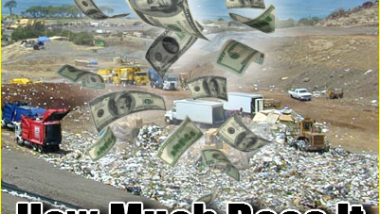Landfill sites are pretty ugly. Landfill problems abound. And it's not just the sight of increasing piles of waste that's the problem. There are many negative issues associated with landfill. The three most important problems with landfill are toxins, leachate and greenhouse gases. Landfill problems are smells, flies and vermin.

Sadly, there are still millions of people and companies all over the world that have yet to understand the potentially highly negative impact on all of us that throwing our trash into a landfill has on the environment, and millions more do understand; but it pleases them to do nothing about it. It has taken decades of public awareness programmes and educational literature to make people start to take responsibility for the environmental disasters that have been caused by an international lack of waste management and recycling.
The Dawn of Awareness of All Those Landfill Problems
It was the 1970s, humans and businesses alike realized it was time to get serious on the topic of airborne pollutants from landfills, clean air technologies, renewable resources, and recycling among others. Recycling had started to become a well known term in the United States, but the recycling industry was still in its infancy.
By the 1990's landfill tonnages were rising by about 3% annually in the UK. Landfills were becoming full more quickly year by year, and thus the constant need for new landfill space had become very burdensome on localities. More and more land was being needed for new landfills. What incinerators remained around the UK, after the stringent EU air-quality regulations of the 1990s had shut most of them down, were at maximum capacity and could not possibly combust any more material from the landfills. Changes had to be made.
UK Decides to “Waste Not Want Not”
Many were deciding that this situation could not continue, and the EU parliament stepped in to make the European Nations all reduce their reliance on landfill sand start to do what the Germans and to an extent the French, Belgians and Dutch had been doing for a while, and invest in recycling in a big way. So, since 2003 the UK has been rapidly increasing it recylicng rates, and the large number of landfills in the UK which were becoming a huge problem, are now growing more slowly. 2011 saw landfilled waste reduce substantially for the first time, and every year both in the UK and the other EU states the amount of waste being sent to landfill is reducing, and the quanity recycled is rising.
Recycled Materials Prices Hit The Floor
But this is not without its problems, the poor state of the EU economies has coincided with the drop in the price of recycled products, so the issue is what to do with all of the waste that we produce, at an affordable cost, both in monetary terms and to the environment.
The breakdown of waste in landfill sites creates huge amounts of the greenhouse gas methane. But, there are also many products that will not breakdown and will remain in the environment forever with the potential to contaminate water supplies.
Much of the waste of today's modern society takes many, many years to decompose. When it does begin to decompose the waste releases toxic pollutants that seep into the water supply, the soil and produces deadly methane gas. Methane gas contributes to the greenhouse gas effect. Which in turn contributes to global warming.
There is still much which isn't recycled in the UK and globally. Traid, a charity specializing in the recycling of textiles reports that 900,000 tons of shoes and clothing are thrown away each year in the UK. Only 200,000 tons per year are recycled and the rest is dumped in landfill. The government estimates that similar amounts of between 550,000 and 900,000 tons of textiles are thrown away each year.
Consider this: according to the Australian state government, over 600,000 tonnes of paper and cardboard are sent to landfill in NSW every year. Australians as a whole use 210,000 tonnes of office paper each year – and much of this is not from recycled sources but from virgin forests.
In the sites of today, the rules are much more stringent as to what can be disposed into landfill sites, however, that's more from the point of view of commercial and industrial wastes, however, that doesn't stop the public from ignoring the WEEE (Waste Electrical and Electronic Goods) Regulations which mean that they must not put these items inot their general waste bins. It also doesn't stop people clearing out their garages from putting that lead-based paint pot in with the rubbish either.
Some people point to the increasing density of waste will reduce as it becomes more processed as a residue, which will ultimately extend the period slightly before all landfills reach their final levels, and are closed. But, even these less reactive processed residual waste will take probably hundreds of years before they decompose to storage quality. That is when no more reactions are taking place and all soluble materials have been leachate out by percolating rainwater, into leachate by solution.
In fact excessive waste compaction has a negative effect as it slows gas production and overall biological activity because as increases the density occurs, permeability reduces decreasing the rate at which water can infiltrate, and “flush out” contaminants from the waste.
What Do We Really Know?
Then there is the lack of knowledge about how the current landfills will really grow old, and how long it will take. There simply is no experience from history for the mega-landfills of today. Put it simply, you have to point out that, nobody can reliably manage landfill problems that they don't know about. Plus, the fact that landfills of the past have been almost as prone to leakage as a sieve, it's pretty important that we know what kind of a chemical pollutant load will really be leaching into our green and pleasant land in 20 or 30, let alone 50 or 100 years time.
Landfill Gas
Well you say: “What about all that energy from landfill gas?” Technology now allows humans to recover methane energy from landfills, which can be used for electricity and powering human civilization!
The production of all that energy from landfill gas utilization sounds very productive, but is it really? In fact, No. Because the gas is only worth using for the first decade or so, after the landfill is completed, covered and buried. Maybe a third of the gas will simply seep out unseen, but just as environmentally damaging, over about a hundred years after the landfill system is shut down.
Landfill Problems: A Plea for YOUR Help With Landfill Recycling
There are many landfill problems. Recycling requires less energy, and fewer raw materials, both of which are important. To create energy we create pollution and discharge carbon which is blamed by many for climate change.
By saving energy we create less pollution. Recycling also saves landfill space.
So, next time you walk over to the bin and carelessly chuck something which you could have recycled into the general waste bin, think about this article. Just stop for a moment to consider how much better it would be for you to take a little more effort and throw it into a recycling container.




